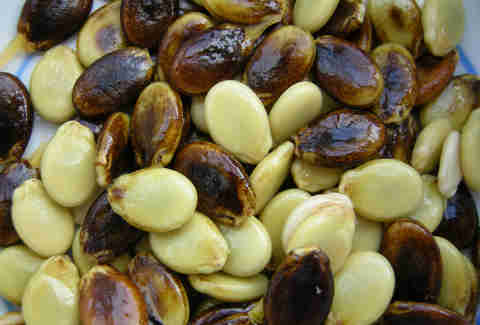https://www.thrillist.com/health/nation/biggest-superfood-health-trends-2017
Sacha inchi nuts
Another nut with a badass name! Maybe this will be the defining characteristic of 2017: nuts with cool names.
If you're sick of the same old almonds and cashews, sacha inchi, or Inca peanuts, are some of the best nuts available. They're packed with heart-healthy omega-3 fatty acids, and with 9g of protein per ounce, you'll start to see the seeds and powder show up more as a form of plant-based protein. You can get them at Trader Joe's, and if that's not a sign sacha inchi's on the cusp of going mainstream, nothing is.

Watermelon seeds
There's a reason plant breeders invented seedless watermelons, and it wasn't to ruin the lives of competitive watermelon seed spitters. But as it turns out, these little black seeds are packed with protein.
So much so, in fact, that a company decided to use them as the primary source of protein in its new line of bars. Go Raw's GROW bars havearound 15g of protein per serving (nothing to scoff at!), all from the discarded part of a fruit. You'll find familiar flavors so that you don't feel like you're eating pressed watermelon seeds -- Dark Chocolate, Mint Chocolate, Zesty Lemon, and Cinnamon Spice are your options. Don't be surprised if other companies and juice bars follow this lead and start using watermelon seeds as a hot new ingredient.
Unique fermented foods
As more people become concerned with their gut health, fermented foodshave taken center stage. They keep things, um, regular, and help balance your gut's microbiome, the collection of good bacteria that everyone needs to stay healthy.
Classic fermented staples like kombucha, kimchee, and sauerkraut are about to be joined by a new crop of fermented veggies. You can ferment pretty much anything, so keep an eye out for tangy, tart versions of cauliflower, beets, and carrots. The Farmhouse Culture brand sells a line offermented vegetables (curry cauliflower and ginger beets sound particularly delicious) so you can get your fix without getting sick of plain old cabbage. With such a focus on gut bacteria, don't be surprised if more variations of fermented produce start popping up.
Savory granola bars
Fruit- and nut-flavored granola bars have been around since the first health-food store opened and have frankly become rather boring. We get it -- cranberries and almonds are delicious together, especially when drizzled with honey.
Enter spicy and savory flavors, like jalapeño, mustard, and roasted peppers. Expect to see more varieties available in the months ahead, with bar giant (it's a thing, seriously) Kashi getting ahead of the game by offering its own line of savory bars. Some of the bold favors included are Basil, White Bean & Olive Oil and Quinoa, Corn & Roasted Pepper.
Sign up here for our daily Thrillist email, and get your fix of the best in food/drink/fun.
..............
http://www.huffingtonpost.com/entry/what-is-sacha-inchi_us_57f276cfe4b0c2407cdecd24
Welcome to the era of superfoods, when eating just one won’t do. We’re always on the lookout for more, even though “superfood” is just a buzzword with no technical definition.
Let us introduce you to sacha inchi, a seed that’s eaten like a nut and might very well be the next big superfood. This is what it looks like:
AXEL FASSIO VIA GETTY IMAGES
At first crunch, it tastes mostly like a nut, but after about 10 seconds, there’s a ... unique ... finishing flavor. Some say it has a buttery finish, but others (all of us here at HuffPost who’ve tasted them) would say it’s a distinctly fishy flavor.
Sacha inchi ― also known as sacha peanut or mountain peanut ― is native to South America and Southeast Asia, and it is infiltrating our Whole Foods and Trader Joe’ssupermarkets. When all’s said and done, one seed is about the size of a large peanut. But before it gets that way, the nutrient-dense seed grows in geometric pods like this:
MEEPOOHYAPHOTO VIA GETTY IMAGES
And the pod looks like this when cut in half:
AKWITPS VIA GETTY IMAGES
So why are we cultivating this fruit for its seeds? Because it has the highest levels of plant-based omega-3s out there. That makes it a great way for vegans and vegetarians to load up on their fatty acids. Imlak’esh Organics, a producer of the snack, claims sacha inchi contains 17 times the omega-3 oil content of salmon, as well as all eight essential amino acids.
Also, one ounce of these seeds contains about 8 grams of protein, which is more than almonds. And, before they’re cracked open to get the seed, they look beautiful like this:
CHORBOON_PHOTO VIA GETTY IMAGES
Sacha inchi are being marketed stateside as a nut ― some salted and some flavored. They can be tossed on top of salads, used in trail mixes and even eaten as is.
What do you think about this superfood? Would you try it?



